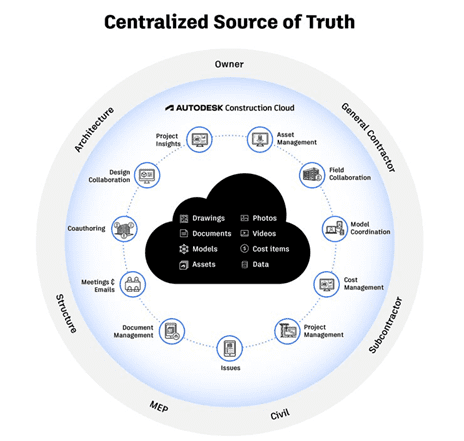Autodesk’s cloud-based solutions enable the seamless gathering and examination of extensive data generated throughout the entire project lifecycle
The storage and processing of information undergo continuous evolution in our digital era. Information has transformed into a valuable currency, prompting every industry to leverage various digital platforms.
These platforms facilitate the exchange and consumption of information among stakeholders, fostering collaboration through shared data and tools.
In the architecture, engineering and construction industry, we have significantly progressed from the traditional practice of sending physical drawings by post for review, with prolonged waits for feedback.
The shift towards digitalisation and 3D modelling has empowered users to collaboratively work on models, breaking down siloed workflows and identifying construction issues well in advance of actual work commencement.
This workflow evolution minimises redundant tasks and eradicates expensive and time-consuming errors during the construction phase of a project.
Cloud-based solutions prevent siloed data from holding your project back
Usually, these files are stored on local physical servers located in individual offices and collaboration is achieved by sharing digital files.
Although these methods are functional, scaling up and enhancing servers often requires significant upfront investments in hardware, particularly given the continual expansion of the data we generate.
Over the past decade, industries across the board have embraced cloud-based solutions
due to advancements in infrastructure and connectivity speeds.
In the Autodesk Architecture, Engineering and Construction (AEC) domain, the initial foray into cloud-based solutions was the BIM360 suite, which empowers construction professionals to engage in every phase of a project, from design and planning to construction and operation.

The Covid-19 pandemic significantly altered collaboration dynamics, prompting a shift to remote work and the need to access data stored in physical office locations.
This has driven companies to adopt cloud-based solutions universally, transcending geographical constraints and facilitating seamless collaboration among project stakeholders.
Autodesk’s AEC offerings have evolved from BIM360 to the comprehensive Autodesk Construction Cloud. Cloud-based collaboration platforms, such as Docs, BIM Collaborate/BIM Collaborate Pro, Takeoff and Build, enable architects, engineers, contractors and clients to access, review and annotate project models and documents in real-time.
These platforms support concurrent work, streamline communication and eliminate version control issues associated with traditional file-based systems. The cloud empowers teams to collaborate effectively, enhance decision-making, reduce errors and expedite project delivery.
Autodesk’s offerings cater to different project phases:
Docs serves as the cloud-based document management and common data environment, forming the foundation of the Construction Cloud.
BIM Collaborate and BIM Collaborate Pro are instrumental in the design phase, providing control over model data exchange and facilitating coordination across disciplines.
BIM Collaborate Pro allows teams to co-author models directly via the cloud.
Transitioning from design to pre-construction involves extracting accurate information from construction documentation for tendering purposes. Autodesk Takeoff, operating from the cloud, enables 2D and 3D quantification, allowing the combination of these quantities.
Effective communication during the construction stage is crucial. Autodesk Build serves as a robust tool for external contractors and onsite/offsite teams to communicate, upload photos, create Requests for Information (RFIs) and maintain real-time communication, regardless of location.
Build also aids in scheduling, cost management and prioritising site safety procedures.
Cloud technology facilitates the collection and analysis of vast project lifecycle data.
Stakeholders can leverage this data for insights and process automation, from initial
design to project handover.
By utilising cloud-based solutions and analytics tools, companies can extract meaningful insights, identify trends, make informed decisions and learn from past projects. This adaptive approach enables evidence-based decisionmaking and continual improvement across project lifecycles.
Rob Merriman
Software Technical Team Lead
Graitec UK
Tel: +44 2380 868947
*Please note: This is a commercial profile.














